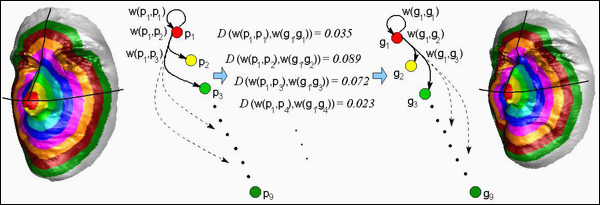In this research, we present a novel approach to 3D face matching that shows high effectiveness in distinguishing facial differences between distinct individuals from differences induced by non-neutral expressions within the same individual. We present an extensive comparative evaluation of performance with the FRGC v2.0 dataset and the SHREC08 dataset.

3D face recognition
The approach takes into account geometrical information of the 3D face and encodes the relevant information into a compact representation in the form of a graph. Nodes of the graph represent equal width iso-geodesic facial stripes. Arcs between pairs of nodes are labeled with descriptors, referred to as 3D Weighted Walkthroughs (3DWWs), that capture the mutual relative spatial displacement between all the pairs of points of the corresponding stripes. Face partitioning into iso-geodesic stripes and 3DWWs together provide an approximate representation of local morphology of faces that exhibits smooth variations for changes induced by facial expressions. The graph-based representation permits very efficient matching for face recognition and is also suited to be employed for face identification in very large datasets with the support of appropriate index structures. The method obtained the best ranking at the SHREC 2008 contest for 3D face recognition.